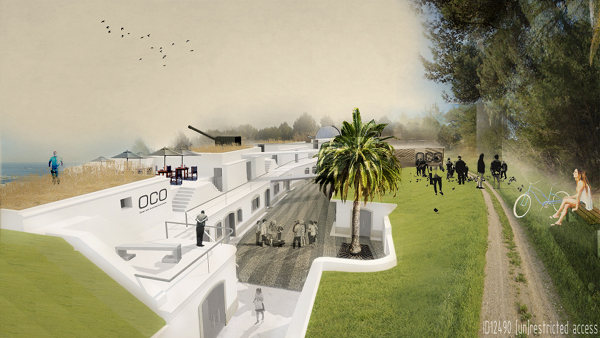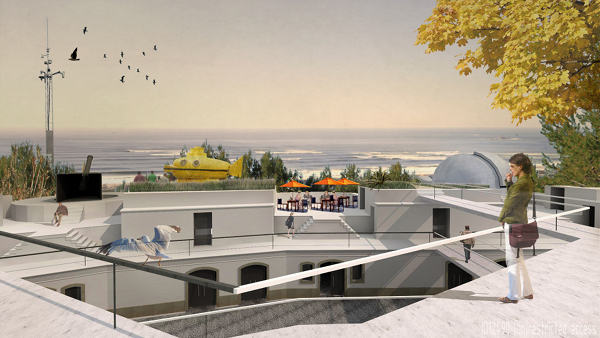A Portuguese military site, reimagined as a coastal conservation center, has taken top honors in this year’s Architecture for Humanity Open Architecture Challenge. The theme of the competition, [UN]RESTRICTED ACCESS, called on architects and designers worldwide to identify retired military installations in their own backyard, and to collaborate with local stakeholders to reclaim these spaces for the greater social, economic, and environmental good. The Challenge Winner in the competition, announced on August 1, is the Ocean & Coastline Observatory (OCO) slated for Caminho da Raposeira Estrada Militar, a decommissioned battery in Trafaria.
Trafaria is is located on the estuary of the Tagus River, on the opposite shore from Lisbon, once a strategic area for the military protection of the Portuguese coastline. Trafaria’s Coast Artillery Regiment 5th Battery was built back in the days when heavy navy canons were the weapon of choice in defending against an attack from sea, and battery’s concrete walls and iron slabs — with simple stonework in the eaves, stairs, windows and doors openings — were built to last. But in recent history, this military base has been abandoned by the Portugese government, with no plans on the part of either the navy/army or local authorities for future development.

The battery also happens to be located in the Costa da Caparica Fossil-Cliff Protected Landscape, comprising 1570 hectares of protected area extending along the coast — which led the Lisbon Architecture Collective to re-interpret this military installation as a battery, so to speak, for coastline protection. By imagining this cannon-laden battery as a center for defending the coast of Portuage against against threats of environmental abuse, the design aims to supervise the sustainable preservation of the coast while helping to preserve Portuguese heritage.
“More than an economic asset,” the design team said, in their statement, “the ocean…defines our identity.” The designers reimagine the old military compound as a place where different area communities (including residents, scientists, researchers, fisherman, sportsmen and students), can meet and share their concerns, plans and ambitions for the coastline.

The proposal calls for the integration of a few staples of park infrastructure (benches, trash cans, and such), outdoor lighting, scientific educational displays, and a network of pedestrian paths that allow visitors to enjoy the natural environment (repopulated by native flora) without trampling it. The battery buildings themselves would make use of sustainable and bioclimatic strategies, including green roofs (already in effect here, quite by accident, as a consequence of the buildings’ age and design), as well as an integrated rainwater harvesting system. Reclaimed water would be used to water the center’s gardens, as well as for general cleaning.
On site renewable energy systems would take the entire facility off the grid, via solar panels and biomass from the surrounding forest and gardens. Organic waste from the center’s kitchen would be composted for use in the garden, and all non-organic wastes separated for recycling.
Unlike most design competitions, the Open Architecture Challenge: UN[RESTRICTED] ACCESS aims to help its winning proposals become a reality by actively soliciting sponsorship for projects. Toward that end, the competition is actively recruiting individuals and organizations “ready to accept the mission of sponsoring the complex yet rewarding task of successfully transforming previously conflicted sites into civic spaces.” The makeover of Trafaria’s 5th Battery is estimated at a cost of around $185, 500 USD and is currently in the pre-design phase.